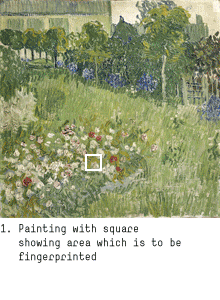Recently, a series of television programmes about art, authentication, and forgeries were broadcast in my area (Fake or Fortune on Knowledge Network) and there was one question I kept asking myself, why aren’t they using some nanotechnology-enabled techniques to decide? I think the answer is pretty simple, they wanted to build suspense rather than answer questions quickly, otherwise, there wouldn’t have been much to broadcast.
Meanwhile, the technology to detect art forgeries and/or to identify art objects continues to be developed as per a Mar. 19, 2013 post by Benjamin Sutton for artinfo.com blog, In The Air (Note: Links have been removed),
An artist’s signature and an artwork’s certificate of authenticity can easily be forged, but you know what cant? A 3D nano-scan of the object’s roughness down to a level as precise as one one-thousandth of a millimeter. That’s exactly how conservation scientist Bill Wei plans to revolutionize the way artworks are authenticated and tracked, Wired U.K. reports, with his new project Fing-Art Print.
Here’s more about the Fing-Art Print system in the Mar. 19, 2013 article by Victoria Turk for Wired UK (Note: A link has been removed),
The Fing-Art Print consists of a NanoFocus uSurf confocal profilometer, which enables non-contact surface analysis, on a robotic arm, measuring tiny differences in height across the object to produce a three-dimensional false colour image. But Wei wants to take the technology beyond the museum. “The idea is to also fight illegal trafficking of archaeological objects,” he explains. The lack of security at digs in the Middle East, for example, makes objects vulnerable to plundering. If they were fingerprinted immediately on discovery, stolen goods could be easily identified.
I found more information about this technique and an illustrative .gif on the Fing-Art Print project website Method page,
How does it work?
- the owner selects an area on the object of several square millimeters
- the micro-roughness of this area is scanned using a non-contact profilometer
- the scan contains roughness information on a micrometer scale
- this unique information is put in a database
This method of examining is nondestructive as stated on the project’s home page,
The FINGaRtPRINT project was conducted in order to develop a system to ”fingerprint” objects of art and cultural heritage. The system provides a long sought after non-destructive, non-contact method for uniquely identifying these objects. Objects and collections which are fingerprinted can be easily identified. As part of an (inter)national database network, fingerprints can be used to re-identify recovered objects and protect against illegal trafficking of cultural heritage.
Btw and for folks like me, the painting in the .gif is The Garden of Daubigny (1890) by Vincent Van Gogh from the Collection Van Gogh Museum Amsterdam (Vincent Van Gogh Foundation).
